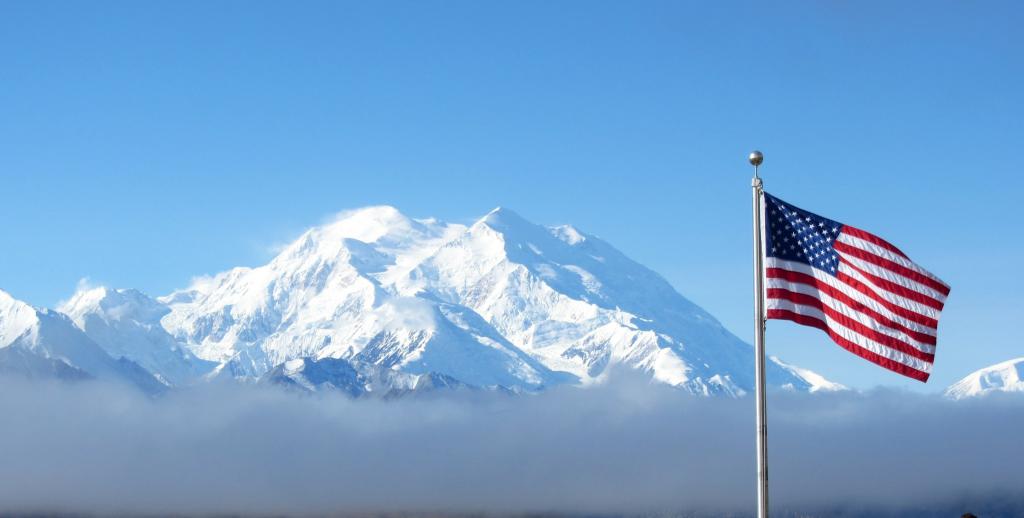There are not so many corners left on Earth that escaped the "caring" hands of a rational person and kept their flora and fauna in its original form, giving a rare opportunity to see what the world looked like before the advent of technological progress. Let's get acquainted with one of them.
What continent is Mount Denali on?
A beautiful region untouched by civilization, preserving the pristine and harsh beauty of wildlife, where rainbow trout splashing in the clear waters of Wonder Lake, herds of caribou graze peacefully, and huge grizzlies walk slowly along the tundra against the background of a summit dissolving somewhere in the clouds Denali mountains. On what continent of our ever-hurrying-smoking planet can such a unique place be located, you ask? This is North America, Alaska (USA). More than a century ago (in February 1917), a national park was founded here, occupying a vast area of about two and a half million hectares (6,075,029 acres), named after its main attraction - Mount Denali.
Upper land border of North America
The unique two-headed Denali is the highest point on the North American continent. Located in the south-central region of Alaska, the mountain peak rises at an altitude of 6190 m above sea level. These data were obtained in September 2015 on the basis of recalculation using GPS shooting, which turned out to be four meters lower than the initial calculation of 1953, made by climber, photographer and cartographer Bradford Washburn.

Mount Denali is located approximately 210 km northwest of Alaska's largest city , Anchorage, and approximately 275 km southwest of the city of Fairbanks. Being a segment of the Alaskan Range and the central part of the national park of the same name, the peak is a giant block of granite that was raised above the earth's crust during a period of tectonic activity, about 60 million years ago. The distance from the plateau where Mount Denali originates to its highest peak (one of two) is 5500 m, which is even higher than Nepalese Everest, which has a distance from its base, located at an altitude of 5200 m above sea level, to the top at 3,700 m. The upper part of the mountain is covered with snowy fields feeding multiple glaciers, some of which extend up to 50 km.
Great seen in the distance
Europeans learned about where Denali Mountain is located thanks to the English explorer and navigator George Vancouver, who in 1794 first saw her from Cook Bay, located off the southern coast of Alaska. In 1839, the Russian pioneer Ferdinand Wrangel marked the mountain on the map as the highest point of the entire Russian Empire at that time, which it remained until it became the property of the American government.
Different names of the Great Peak
Local residents called this stone giant Koyukony Denali, which is translated from Atapask means great or high. In much the same way, Big Mountain, it was also called by Russian settlers. In 1889, traveler Frank Densmore modestly called the mountain his name. However, already in 1896, the gold digger and explorer William Dickey, proposed to name the peak in honor of McKinley Jr., who became the 25th President of the United States at speed. He never visited his mountain of the same name, as, however, other parts of Alaska. The name McKinley has become official for the peak and adjacent national park for many decades.
By the mid-1970s, efforts had been made to restore the root name, but they came up against resistance, mainly from lawmakers from Ohio, President McKinley’s home state. Despite the fact that the state of Alaska officially changed its name to Denali in 1975 and requested the US Congress to confirm the renaming of the territory, only in 1980, when the park was enlarged three times, it was returned its historical name. At the same time, the federal government retained the name of Mount McKinley.
But time passed, a new old name became more and more common among visitors to the park and the public, and in the summer of 2015, with the approval of President Obama, the Department of the Interior officially renamed the ancient peak to Mount Denali.
The Taming of the Shrew Mountain
Over the history of the Great Mountain, its summit was conquered many times, but not all attempts were successful, or rather about 60% of all. Located in high latitudes, with a gusty wind and temperatures dropping to -35 ° C (and readings of -83 ° C were recorded near the summit), it killed almost a hundred thrill seekers on its snowy slopes, and this list is updated annually.
The first unsuccessful attempt to conquer the heights was made in 1903 by an American judge, James Vickers. Then the doctor and researcher Frederick Cook, in 1906, announced the conquest of Denali, although a debate on whether he was there or not continues to this day. Among those who undoubtedly were among the first to visit the top peak of North America include Hudson Stack, who in 1913, through incredible efforts, finally achieved the dream of many climbers. His ascent continued for almost four months (from March 17 to June 7).
"Die Hard" for all climbers
The modern climbers of Denali Mountain reach the base camp located on the Kahiltna Glacier (the southern slope of the mountain at an altitude of 2195 meters), from where they already begin their ascent to the summit via several well-known routes.
About 600 thousand people visit the Denali Nature Reserve every year, mainly from May to September, and this figure is growing year by year. At the beginning of the 2017 climbing season, according to the park's administration, about 800 climbers climbed the mountain.
Even experienced guides accompanying travelers on an ascent climb classify the route as extremely difficult due to severe weather and difficulties in acclimatization.
And the mountain stands, contented and impregnable, over the past 59.99 million years, no one has yet given it so much attention.